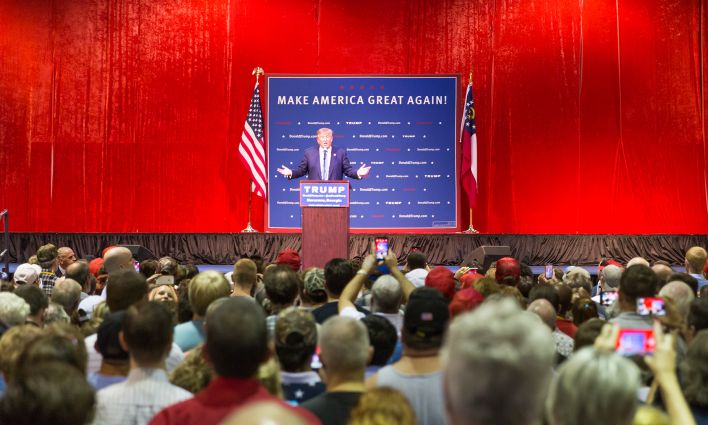Some time in 1914, Ivy Lee was contacted by the Rockefellers.
Standard Oil, the American fossil fuel giant owned by the Rockefeller family, was in trouble. Following a long strike by coal miners in Colorado, the company hired a militia to clear striking workers’ protest encampment in the town of Ludlow. In clearing the camp, the strikebreaking militia killed 60 people, including children, and burned the workers’ tent city.
In the public backlash that followed, Standard Oil hired Lee, one of the fathers of the modern discipline of public relations, to clean up the mess. Lee—the man who invented the press release and press conference—got to work immediately demonizing the strikers. He fabricated a lie that those killed were not actually workers in the coal field, they were hired agitators on the union payroll. He also concocted a bizarre and unsubstantiated story that 82-year-old union leader Mother Jones was running a nearby brothel.
In the confusion that followed, Lee succeeded in rehabilitating the Rockefellers’ image. No longer were they greedy oligarchs who used violence and terror to put down opponents, but rather patriotic industrialists and philanthropists. Ivy Lee worked with Standard Oil—along with other unsavoury characters in the tobacco industry and Nazi Germany—for the rest of his life.
Decades later, when asked about his work covering up the Ludlow Massacre, Lee summarized his view of the work with a question: “What are facts, anyway, but my interpretation of what happened?”
The confusion factory
Before it was called public relations, it was called propaganda. Many of the people who built the modern PR industry got their start in the Committee on Public Information, the propaganda arm of the American government, which aimed to sell the deeply unpopular First World War to the American public. Among other tactics, the CPI pioneered the use of what we would now recognize as “influencers” in a program called the “four-minute men” in which they recruited community leaders to show up to parties, silent film screenings, and community events to give short speeches in favour of the war.
CPI alumni Edward Bernays—the nephew of psychology pioneer Sigmund Freud, who put his uncle’s insights to use to create propaganda—coined the term “public relations” after the term “propaganda” fell out of fashion due to association with Germany. Bernays was a firm believer that the public were sheep to be led by a ruling elite using the techniques of crowd psychology. In his book Propaganda, he wrote that “The conscious and intelligent manipulation of the organized habits and opinions of the masses is an important element in democratic society. Those who manipulate this unseen mechanism of society constitute an invisible government which is the true ruling power of our country.”
The PR industry really picked up steam in the decades after the Second World War—driven, in significant part, by veterans of U.S. Army psychological warfare operations like Daniel Edelman and Herb Schmertz. During these years, the PR industry developed a toolkit of tactics and strategies to obscure the truth and protect entrenched interests. While this principle applied across corporate PR, certain industries were consistently at the cutting edge of disinformation production, especially tobacco and fossil fuels.
John Hill—founder of Hill & Knowlton, which remains one of the world’s largest PR firms—pioneered what some observers call the “merchants of doubt” method, largely in work for the tobacco industry. This method, analyzed in detail in the book of the same name by science historians Naomi Oreskes and Erik Conway, is based on hiring scientists who reject a scientific consensus that is harmful to industry and platforming those scientists in public to dispute the consensus.
Hill helped the tobacco industry create the Tobacco Industry Research Committee (TIRC), which hired groups of “expert” scientists to sow confusion around the links between smoking and cancer. TIRC scientists spent much of their time researching causes of cancer beyond smoking, with the goal of presenting cancer as something too difficult to narrow down as causal.
Such tactics were adopted by large corporations across industries, notably in the fossil fuel industry, which hired teams of researchers to study how the demonstrable warming of the earth could be caused by things other than fossil fuels—despite companies like Exxon having proof of the link between fossil fuels and climate change as early as the late-1970s.
The point, across industries, was not to prove their opponents wrong, it was to create confusion. If the public believed that there was a legitimate debate going on, rather than a settled scientific consensus, then they would be less likely to pressure a complacent government to take action and rein in corporate damages.
“What are facts, anyway, but my interpretation of what happened?” — Public Relations pioneer Ivy Lee
This “confusion factory” developed many products. They created the concept of “astroturfing,” in which PR firms or industry groups fund the creation of fake grassroots (hence “astroturf”) organizations to advocate on their behalf. The tactic was pioneered by Edward Bernays in a campaign for the tobacco industry called “torches of freedom,” which encouraged women to begin smoking cigarettes. Bernays launched the campaign by hiring women actors to smoke while marching in a parade and alerted members of the press that a group of “feminists” would be breaking the taboo against women smoking in public.
Such a front group is amateur by today’s standards, but was groundbreaking at the time. It set the stage for all manner of industry-funded front groups that would emerge in the decades to come. From the American government fabricating a story about Weapons of Mass Destruction in Iraq to sell an imperial war of occupation, to the fossil fuel industry’s continued efforts to minimize its role in ecosystems collapse, the world of officially sanctioned disinformation is alive and well, and continuously innovating new ways to manipulate the public.
Networked distribution
If the military propaganda and PR industry created a sort of “official disinformation,” sanctioned by powerful corporations and governments, it’s important to also understand that other place where disinformation breeds: among networks of grassroots actors, generally on the far-right. Unlike corporate disinformation, this type of disinformation it diffused and it spreads via decentralized networks.
Diffused disinformation has gotten a lot of attention over the past few years—beginning with concern over the spread of disinformation online after Brexit and the election of Donald Trump and really heating up with the tidal wave of online disinformation that accompanied the COVID-19 pandemic.
These categories are, of course, not mutually exclusive—nor is their distinction particularly novel. One of the most harmful pieces of disinformation in history was the Protocols of the Elders of Zion, a forged text created by the Okhrana, the Tsarist Russian secret police, to foment hatred against Jews. The text purported to be the minutes of a “secret meeting” of Jewish leaders plotting world domination. Despite the fact that the document was quickly proven to be a fake, it served as a key inspiration for the German Nazis and the atrocities they committed. No matter how many times it has been debunked, the text continues to be referenced by neo-Nazis today, even with no Okhrana to propagate it. This piece of disinformation emerged from a centralized point in the confusion factory then circulated through decentralized disinformation networks managed by dispersed far-right actors.
Producing disinformation is extremely profitable
Perhaps no piece of modern disinformation fits the “networked” archetype better than QAnon, a conspiracy theory and movement centered around a fictional character named Q, who followers believe to be a member of the U.S. government who uses access to classified information to reveal bizarre conspiracies involving pedophilia and satanism. Since its emergence in 2017 on the the now-defunct hate forum 8chan—likely from the imagination of a 8chan founder Jim Watkins, a former American soldier turned Philippines-based pig farmer and accused child pornographer—the conspiracy has metastasized into a real-world movement and penetrated the Republican party, with support from serving congresspeople, presidential advisors, and even Donald Trump himself.
Once it broke out of 8chan, the QAnon delusion spread rapidly through mainstream social media outlets. Facebook, in particular, but also Youtube, Twitter, and more. Placards reading “Q sent me” and the “great awakening” (a QAnon slogan) began showing up at Trump rallies. Adherents came to believe increasingly unhinged and apocalyptic narratives about a coming rapture, in which their political opponents—all of whom are, by default, treated as satanists and pedophiles—would be purged from public life through violent retribution led by Donald Trump. Such fantasies played a major part in the fascist uprising on January 6, 2021, in which thousands of Trump supporters attempted to overturn the results of the 2020 presidential election and institute Trump as unelected president.
The January 6 coup attempt appears to have been the high-water mark for QAnon, as followers deserted the cult-like network following the failure of Donald Trump to hold on to the presidency, which they viewed as a sign that Q’s predictions had been lies. Combined with decisions by Twitter and (Facebook parent-company) Meta to ban QAnon content from their platforms, the conspiracy theory has seen a decline over the past two years, but continues to inform the ideology of the North American far-right, including the so-called “freedom convoy” which occupied Ottawa for a month in early 2022.
From a trickle to a fire hose
America’s tech giants have revolutionized the global disinformation industry. No longer do individuals who are prone to conspiratorial thinking need to seek out newsletters or meetings with local chapters of the John Birch Society or the Heritage Front. Now, agents of disinformation can access large swaths of the public with relative ease.
Producing such disinformation is also extremely profitable. Infowars, the disinformation network run by conspiracy theorist Alex Jones, was banking nearly $800,000 per day during a peak in 2018. Much of that revenue came from direct donations and sales on the website, but a significant portion of it also came from ad sales on mainstream social media sites like Facebook before the outlet was banned in 2019.
Jones is perhaps most well-known for his baseless claim that the children who were murdered by a mass shooter at Sandy Hook elementary school were actually actors—a claim that echoed the one made by PR pioneer Ivy Lee 100 years earlier, following the Ludlow Massacre.
Ad tech companies, including Google’s AdSense, make it very easy to monetize websites through ad sales. A 2019 study by the Global Disinformation Index found that, among 20,000 misinformation websites, over 70 per cent were served by Google, providing approximately 37 per cent of their revenue, or $86 million annually.
The rapid-fire circulation of disinformation, especially via platforms with widespread adoption, like Facebook, can have dire consequences. Perhaps the most grim example of this reality is Facebook’s key role in the 2017 genocide of the Rohyinga people in Myanmar, in which at least 10,000 members of the Muslim minority were killed and around a million displaced to refugee camps in neighboring Bangladesh. The violence was stoked primarily through Facebook, which failed to stem the tidal wave of disinformation and calls to violence on its platform.
Facebook whistleblower Frances Haugen, who leaked a trove of internal company documents to the Wall Street Journal in 2021, revealed that while only 10 per cent of Facebook users are North Americans, 87 per cent of Facebook’s counter-disinformation budget is targeted towards the United States—and that lion’s share still fails to adequately address the scale of disinformation targeted towards Americans on its platform.
Bringing the war home
Disinformation in the era of Facebook and Google is a Frankenstein’s monster. It has combined the titanic resources associated with the “official disinformation” of PR, industry, and governments, with the paranoid calls to violence associated with fringe conspiracy networks. It has created a social tinder box, ready to spark. In many countries of the Global South, where America’s tech giants don’t care to dedicate resources, those sparks have already turned to wildfires.
But the metastasization of disinformation of the past few years did not occur in a vacuum. It builds on a hundred years of official propaganda, in which the public relations industry (and the clients they served) honed the ability to make the public question baseline reality, distrust scientists and experts, and identify with the most powerful people and classes, rather than the downtrodden.
While the “conscious and intelligent manipulation of the organized habits and opinions of the masses,” as Edward Bernays put it, used to be the confines of a small number of powerful individuals, that is no longer the case. Such tactics—which have always been used to foment violence, as seen in their origins in WWI—are now widely accessible through tech companies.
It’s unclear how societies can put that genie back into the bottle, but if it is possible, it will require tackling not just the fringe conspiracy theories that propagate via networks, but also the official channels that have fostered disinformation as an exclusive domain of the powerful.
From John D. Rockefeller to Donald Trump, disinformation has always been a tool the powerful use to protect themselves. The tactics may have changed, but the poison remains the same.







